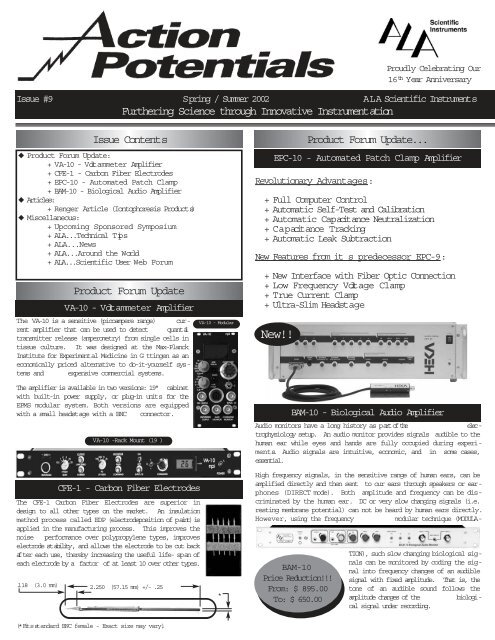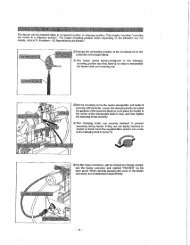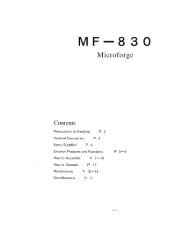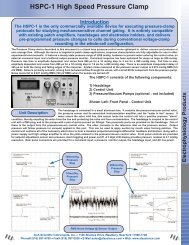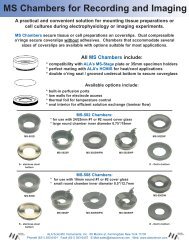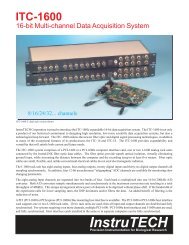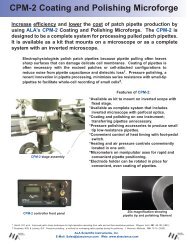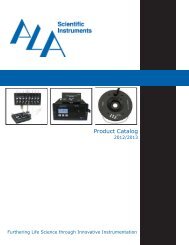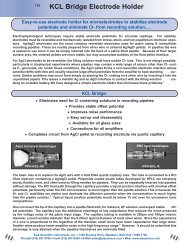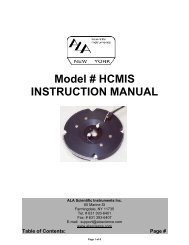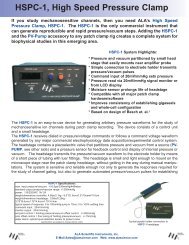Action Potentials Issue #9 - ALA Scientific Instruments
Action Potentials Issue #9 - ALA Scientific Instruments
Action Potentials Issue #9 - ALA Scientific Instruments
You also want an ePaper? Increase the reach of your titles
YUMPU automatically turns print PDFs into web optimized ePapers that Google loves.
Proudly Celebrating Our<br />
16 th Year Anniversary<br />
<strong>Issue</strong> <strong>#9</strong> Spring / Summer 2002 A L A <strong>Scientific</strong> <strong>Instruments</strong><br />
Furthering Science through Innovative Instrumentation<br />
<strong>Issue</strong> Contents<br />
Product Forum Update:<br />
+ VA-10 - Voltammeter Amplifier<br />
+ CFE-1 - Carbon Fiber Electrodes<br />
+ EPC-10 - Automated Patch Clamp<br />
+ BAM-10 - Biological Audio Amplifier<br />
Articles:<br />
+ Renger Article (Iontophoresis Products)<br />
Miscellaneous:<br />
+ Upcoming Sponsored Symposium<br />
+ <strong>ALA</strong>...Technical Tips<br />
+ <strong>ALA</strong>...News<br />
+ <strong>ALA</strong>...Around the World<br />
+ <strong>ALA</strong>...<strong>Scientific</strong> User Web Forum<br />
Product Forum Update<br />
VA-10 - Voltammeter Amplifier<br />
The VA-10 is a sensitive (picoampere range) current<br />
amplifier that can be used to detect quantal<br />
transmitter release (amperometry) from single cells in<br />
tissue culture. It was designed at the Max-Planck<br />
Institute for Experimental Medicine in G ttingen as an<br />
economically priced alternative to do-it-yourself systems<br />
and expensive commercial systems.<br />
The amplifier is available in two versions: 19" cabinet<br />
with built-in power supply, or plug-in units for the<br />
EPMS modular system. Both versions are equipped<br />
with a small headstage with a BNC connector.<br />
VA-10 -Rack Mount (19 )<br />
VA-10 - Modular<br />
Product Forum Update...<br />
EPC-10 - Automated Patch Clamp Amplifier<br />
Revolutionary Advantages:<br />
+ Full Computer Control<br />
+ Automatic Self-Test and Calibration<br />
+ Automatic Capacitance Neutralization<br />
+ Capacitance Tracking<br />
+ Automatic Leak Subtraction<br />
New Features from it s predecessor EPC-9:<br />
+ New Interface with Fiber Optic Connection<br />
+ Low Frequency Voltage Clamp<br />
+ True Current Clamp<br />
+ Ultra-Slim Headstage<br />
New!!<br />
BAM-10 - Biological Audio Amplifier<br />
Audio monitors have a long history as partofthe<br />
electrophysiology<br />
setup. An audio monitor provides signals audible to the<br />
human ear while eyes and hands are fully occupied during experiments.<br />
Audio signals are intuitive, economic, and in some cases,<br />
essential.<br />
CFE-1 - Carbon Fiber Electrodes<br />
The CFE-1 Carbon Fiber Electrodes are superior in<br />
design to all other types on the market. An insulation<br />
method process called EDP (electrodeposition of paint)is<br />
applied in the manufacturing process. This improves the<br />
noise performance over polypropylene types, improves<br />
electrode stability, and allows the electrode to be cut back<br />
after each use, thereby increasing the useful life- span of<br />
each electrode by a factor of at least 10 over other types.<br />
.118 (3.0 mm)<br />
2.250 (57.15 mm) +/- .25<br />
*<br />
High frequency signals, in the sensitive range of human ears, can be<br />
amplified directly and then sent to our ears through speakers or earphones<br />
(DIRECT mode). Both amplitude and frequency can be discriminated<br />
by the human ear. DC or very slow changing signals (i.e.<br />
resting membrane potential) can not be heard by human ears directly.<br />
However, using the frequency<br />
modular technique (MODULA-<br />
BAM-10<br />
Price Reduction!!!<br />
From: $ 895.00<br />
To: $ 650.00<br />
TION), such slow changing biological signals<br />
can be monitored by coding the signal<br />
into frequency changes of an audible<br />
signal with fixed amplitude. That is, the<br />
tone of an audible sound follows the<br />
amplitude changes of the biological<br />
signal under recording.<br />
(*Fitsstandard BNC female - Exact size may vary.)
Feature Article: Iontophoresis Products - Non-equilibrium activation of ligand-gated receptors<br />
through ultrafast micro-iontophoresis<br />
John J. Renger, Ph. D.<br />
Synapses are the fundamental functional unit within the nervous system<br />
for communication between neurons and essential in processes<br />
such as learning and memory, yet these dynamic structures remain relatively<br />
poorly understood. Synapses continue to conceal their<br />
secrets largely because techniques are unavailable to directly measure<br />
the process of synaptic transmission in real time and at individual<br />
identifiable synapses. Further, the study of synaptic transmission<br />
is easily confounded by ongoing changes in the state of the presynaptic<br />
terminal (e.g. synaptic vesicle depletion, residual calcium,<br />
changes in the number of vesicle fusion events, etc.), the post synaptic<br />
membrane (density and distribution of receptors, receptor<br />
conductance, etc.), or other, as yet unknown, alterations. Additionally,<br />
much of what has been inferred about synaptic function is based on<br />
the population behavior of synapses (ie. field recording, recording from<br />
various neuromuscular junction preparations, whole-cell recording<br />
from neurons with many tens to hundreds of synaptic connections), not<br />
on the properties of individually identifiable release sites. To more precisely<br />
examine synaptic transmission at identifiable synapses, we can<br />
eliminate many assumptions regarding presynaptic neurotransmitter<br />
release by using ultrafast micro-iontophoresis both in<br />
conjunction<br />
with, or in place of, endogenous neurotransmitter release.<br />
Ultrafast micro-iontophoresis is a powerful research tool for examining<br />
functional receptor distribution on neuronal arbors. In addition, this<br />
technique permits the direct determination of receptor activation, inactivation,<br />
and desensitization with non-equilibrium applications of<br />
ligand. This approach has further revealed a new mechanism for the<br />
relative activation of receptors within synapses that contain mixed<br />
receptor types.<br />
Often research focuses on the properties of<br />
neurotransmitter-gated<br />
receptors under equilibrium conditions of ligand.<br />
This may largely reflect the ease with which bulk application of<br />
ligand can be carried out. However, bath application of a neurotransmitter<br />
is non-physiological condition and akin to pathological<br />
conditions. At equilibrium, ligand-gated receptors fail to recapitulate<br />
the normal physiological<br />
characteristics seen when neurotransmitter<br />
is applied very briefly (over the range of microseconds to<br />
milliseconds) as occurs during synaptic transmission. Thus, it<br />
should be understood that during normal synaptic transmission ligandgated<br />
receptors are activated under non-equilibrium conditions.<br />
Furthermore, complications from receptor internalization, desensitization,<br />
and inactivation are most likely to occur over long periods (seconds<br />
or greater) of bath applied transmitters/ ligands which may lead<br />
to inaccurate conclusions regarding receptor function. Therefore, to<br />
best understand the physiological properties of neurotransmitter<br />
receptors, the application of neurotransmitter must closely mimic the<br />
temporal and spatial characteristics of normal<br />
neurotransmission.<br />
It is possible to apply neurotransmitter in a near-physiological manner<br />
using a state-of-the-art iontophoresis amplifier (MVCS-02C, npi<br />
electronic; c.f. Figures 4A and 4C in Liu et al., 1999). Comparisons of<br />
iontophoresis-evoked A M PA<br />
(a-amino-3-hydroxy-5-<br />
methyl-4-isoxazolepropionic acid) receptor responses to brief applications<br />
(1 ms duration, 100 nA; 100 m (Rseries iontophoresis electrode)<br />
of neurotransmitter (150 mM Na-glutamate, pH 7.0) with<br />
endogenous miniature synaptic transmission events, showed that this<br />
iontophoresis system was capable of faithfully and stably reproducing<br />
synaptic-like responses with less variability than endogenous<br />
neurotransmission (c.f. Figure 5 Liu et al., 1999).<br />
The ultrafast micro-iontophoresis technique can also be applied to<br />
answering questions as to how, when, what types, and under what<br />
conditions, functional ligand-gated receptors enter synapses during<br />
development. Cottrell et al., (2000) used micro-iontophoresis to<br />
establish the early appearance of functional NMDA (n-methyl-Daspartate)<br />
receptors and A M PA receptors and their clustering at<br />
synapses during development. Using repetitive iontophoresis applications<br />
in combination with computer-controlled robotic micromanipulation,<br />
this group was able to "map" functional glutamate receptors along<br />
dendritic arbors.<br />
A recent application of ultrafast micro-iontophoresis demonstrated<br />
that varying the amplitude-duration parameters of iontophoresis<br />
ejection pulse leads to dramatic alterations in the ratio of A M PA and<br />
NMDA receptor activation (Figure 1; and see Renger et al., 2001).<br />
This approach directly demonstrated that the concentration-duration<br />
profile of neurotransmitter is a critical feature for determining how the<br />
physiological function of the different receptor types can be selectively<br />
controlled within a single synapse. In these experiments, it was<br />
shown brief pulses of glutamate (ejection pulse = 1 ms duration, 100<br />
nA amplitude) were effective at activating both A M PA and NMDA<br />
receptors, while applying the same total amount of transmitter over a<br />
longer time period (ejection pulse = 10 ms duration, 10 nA amplitude)<br />
was efficacious for the preferential activation of NMDA receptors. This<br />
selective activation of receptor types during non-equilibrium application<br />
of neurotransmitter demonstrates the necessity of using nearphysiological<br />
activation of ligand-gated receptors to understand their<br />
biological function.<br />
To test hypotheses regarding receptor activation, inactivation, and<br />
desensitization during endogenous transmitter release, ligandgated<br />
receptors need to be examined with stable ultrafast applications<br />
of neurotransmitter that reproduce endogenous release parameters as<br />
closely as possible. To carry out this approach in our experiments,<br />
several important technical issues needed to be addressed. As reported<br />
in Liu et al. (1999), for mimicking endogenous release it was<br />
important that the time constant of the iontophoresis electrode be minimized.<br />
In order to accomplish this, we used quartz capillary glass and<br />
a Flaming-Brown laser puller to design electrodes that have a tip<br />
inner diameter
Feature Article: Iontophoresis Products - Non-equilibrium activation of ligand-gated receptors<br />
through ultrafast micro-iontophoresis...<br />
To guide the electrode among synapses, a confocal microscope was<br />
used in conjunction with robotic manipulators so that the tip of the electrode<br />
could be placed within 1 micron of the putative synaptic terminals.<br />
The distance between the electrode tip and the synapseiscritical<br />
for determining the efficacy of the response, as shown by the dramatic<br />
drop in the response in mapping experiments from Liu’s group<br />
(Cottrell et al., 2000, Renger et al., 2001). Thus, careful consideration<br />
must be made in designing the optics of the system with which this<br />
technique is used. It is also important to note that this system can<br />
theoretically be used for the application of many charged molecules.<br />
For some neurotransmitters, it is necessary to consider the<br />
pKa of the molecule and adjust the pH accordingly in order achieve a<br />
net charge on the molecule for its use in iontophoresis. We have<br />
been successful in using this device for GABA iontophoretic application<br />
by acidifying the solution in which GABA is dissolved (pH 4.0).<br />
Figure 1: Concentration-duration profile of neurotransmitter determines<br />
A M PAR/ NMDAR activation at an individual synapse.<br />
Iontophoresis - MVCS-02C Series<br />
The ONLY iontophoresis<br />
system that simulates<br />
synaptic events!<br />
Allows receptor mapping. Spatial resolution: 1 M<br />
Using an advanced capacitance compensation circuit the MVCS<br />
system allows very fast drug applications. Time<br />
resolution:500 s<br />
Automated balancing of iontophoretic current<br />
<br />
Currents from tens of pA to hundreds of A<br />
<br />
High-voltage, high-speed current source<br />
<br />
Automated electrode resistance test<br />
Select References:<br />
1) G. Liu et al. (1999), Neuron, Vol. 22, 395-409. 1999<br />
2) J.J. Renger et al. (2001), Neuron, Vol. 29, 469-484. 2001<br />
3) Cottrell et al., J. Neurophysiol., Vol 84, 1573-1587. 2000<br />
A. Schematic of the experimental design for iontophoretic examination<br />
of postsynaptic receptors. The iontophoresis electrode is<br />
brought to within 1 m of an isolated synapse. Filled vertical and horizontal<br />
bars represent the "Fast" (1 ms, 100 nA) and "Slow" (10 ms, 10<br />
nA) iontophoretic application parameters.<br />
B. "Slow" iontophoretic pulses preferentially elicited NMDAR-only<br />
responses from synapses on a voltage clamped hippocampal neuron,<br />
while "Fast" pulses elicited A M PAR and NMDAR responses from the<br />
same site. A M PA receptors failed to activate in the presence of a<br />
"Slow" flux of glutamate. This data demonstrates that "AMPA-quiet"<br />
responses can be generated at synapses with functional A M PAR’s<br />
(modified from Renger et al., 2001).<br />
As our understanding of the complexities of the synaptic transmission<br />
process advance, we will design better and more accurate tests<br />
of the function of these intriguing structures called synapses. A significant<br />
requirement for this advancement is our ability to identify and utilize<br />
the technologies that allow us to precisely reproduce physiological<br />
events, as we understand them. Currently, ultrafast micro-iontophoresis<br />
is a technology that most faithfully reproduces endogenous<br />
synaptic<br />
transmission and as such, enables experiments to<br />
uncover the next trove of hidden secrets of the synapse.<br />
A Merck-MIT Fellowship and RIKEN-MIT Fellowship supported JJR.<br />
W ork described here was also funded by NIH and RIKEN grants to G.<br />
Liu at MIT.<br />
John J. Renger, Ph. D.<br />
RIKEN Neuroscience Center, Center for Learning and Memory<br />
Massachusetts Institute of Technology, 77 Massachusetts Avenue<br />
Cambridge, MA 02139<br />
Current Address: WP 26-265, Molecular Pharmacology<br />
Merck & Co. Inc., 770 Sumneytown Pike, West Point, PA 19486<br />
W e are now accepting tips for future issues of <strong>Action</strong> <strong>Potentials</strong>.<br />
These applications should be relevant to a wide variety of scientists<br />
but need not be limited to the use of A L A products.<br />
W e welcome any information that will be useful to<br />
<strong>Action</strong> <strong>Potentials</strong> 5000+ readers.<br />
<br />
<strong>ALA</strong>...<strong>Scientific</strong> User Web Forum<br />
W e are happy to provide the scientific community with<br />
moderated<br />
forums. Simply visit our web site (www.alascience.com), follow<br />
the link to A L A Forum and post your message on existing forums or<br />
create a new forum.<br />
Current Forum Topics:<br />
<br />
<br />
<br />
Technical Tips<br />
To submit, please email your idea to: andyp@alascience.com<br />
<strong>ALA</strong>...News<br />
<strong>Action</strong> <strong>Potentials</strong> Fall/Winter 2002 Preview<br />
<strong>ALA</strong> s new 8-Trode , for in vivo extracellular recoding with chronic<br />
or active implantation<br />
<strong>ALA</strong>...Around the World<br />
Society for Research on Biological Rhythms Meeting (SRBR) 2002<br />
-Amelia Island, FL - May 22-26, 2002<br />
Forum of European Neuroscience (FENS) 2002 - Paris, France,<br />
July 13-17, 2002 - Symposium From Networks to Molecules<br />
Society for Neuroscience 2002 - Orlando, FL - November 2-7, 2002<br />
-Sponsored Symposium Planned - TBA<br />
Biophysical Society 2003 - San Antonio, TX - March 2-4 2003<br />
M E A Recording Discussion & Feedback on MEA system from<br />
MultiChannel Systems.<br />
Perfusion Forum Setup, Troubleshooting, General Questions.<br />
Amplifiers General Questions & Comments
Furthering Science through Innovative Instrumentation<br />
PRSRT STD<br />
AUTO<br />
U.S. POSTAGE PAID<br />
Hicksville, NY<br />
Permit No. 73<br />
To:<br />
<strong>ALA</strong>s Products<br />
Categories<br />
Drug Discovery Products<br />
Microincubators, Recording Chambers &<br />
Temperature Controllers<br />
Electrophysiology Products<br />
Micropipette Positioning & Fabrication<br />
Pipette Holders & Electrodes<br />
Miscellaneous & Accessories<br />
See our updated<br />
W orld-Wide Exhibition<br />
Schedule Inside<br />
1100 Shames Drive<br />
W estbury, NY U S A<br />
11590-1746<br />
Tel#<br />
516-997-5780<br />
Fax #<br />
516-997-0528<br />
E-Mail:<br />
sales@alascience.com<br />
Internet:<br />
w w w.alascience.com


